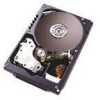IBM IC35L036UWDY10 Hard Drive Specifications - Page 204
Ignore Wide Residue 2301h, 1.20 Identify 80 - Ffh, 1.18.2 Head Of Queue 21xxh
 |
UPC - 000004119524
View all IBM IC35L036UWDY10 manuals
Add to My Manuals
Save this manual to your list of manuals |
Page 204 highlights
10.1.18.2 HEAD OF QUEUE (21xxh) Commands with this tag should be inserted into the head of the queue. When a command is being executed, this tagged command will be inserted to the head of queue to be executed after the command being currently executed. The previous executed command will not be terminated by this tagged command. This tagged command will wait until the previous command is completed. If plural head-of-queue tagged commands are received, those command will be executed in LIFO (Last in First out) order. 10.1.18.3 ORDERED (22xxh) This tagged command is executed in the order received. All commands received before this command should be executed before this command and all commands received after this command should be executed after this command. 10.1.19 IGNORE WIDE RESIDUE (2301h) Byte Value 0 23H 1 01H Description Ignore Wide Residue message Ignore Figure 191. Ignore Wide Residue Message Format The IGNORE WIDE RESIDUE MESSAGE is sent from the drive to indicate that the number of valid bytes sent during the last REQ/ACK handshake of a DATA IN phase is less than the negotiated transfer width. The ignore field (always = 01h) indicates that one byte (data bits 8-15) should be ignored. This message is sent immediately after the DATA IN phase and prior to any other messages. Even though a byte is invalid, it's corresponding parity bit is valid for the value transferred. 10.1.20 IDENTIFY (80 - FFh) This message is set by either the initiator or the drive to establish the logical path connection between the two devices. The IDENTIFY message is defined as follows: Bit 7 This bit is always set to one to distinguish the IDENTIFY message from other messages. Bit 6 This bit is only set to one by the initiator to grant the drive the privilege of disconnecting. If this bit is zero, the drive will not disconnect unless the initiator instructs the drive to disconnect by sending a DISCONNECT message to the drive. This bit is set to zero when the drive sends an IDENTIFY message to the initiator. Bits 5-0 These bits specify the logical unit number (LUN). Only one LUN may be identified for any one selection sequence. If the drive receives an IDENTIFY message with a new LUN after the LUN had previously been identified, the drive will go to the BUS FREE phase to signal a catastrophic error. The initiator may send more than one Identify message during a selection sequence in order to toggle disconnect/ reconnect permission if the specified LUN remains the same. When the IDENTIFY message is sent from the drive to the initiator during reconnection, an implied RESTORE POINTERS message must be performed by the initiator. Ultrastar 146Z10 hard disk drive specifications 188















